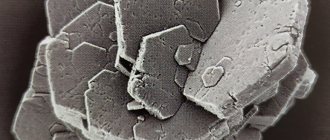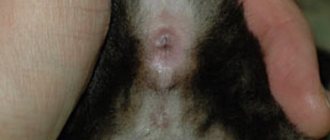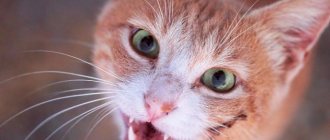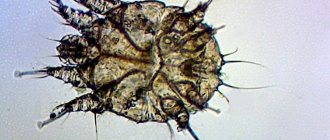An acute lack of oxygen caused by impaired respiratory function can result in the sudden death of a beloved pet. One of the reasons for this complication is excessive accumulation of fluid in the alveoli, accompanied by swelling of the lung tissue.
Symptoms and methods of treating pulmonary edema in cats depend on the form of the pathology. All owners of mustachioed pets are advised to know the main features of the disease, since if it is detected, first aid will have to be provided independently.
What is pulmonary edema in cats?
The respiration process of mammals is based on gas exchange. The body regularly takes in oxygen, feeding its cells, and releases excess carbon dioxide resulting from metabolic processes into the environment.
Alveoli, small cells located at the base of the bronchi, are responsible for inhalation and exhalation. They are surrounded by numerous capillaries and vessels filled with blood. If lymph or other liquid ends up in a cat’s lungs, the gas exchange process is disrupted. Cells deprived of oxygen gradually die from hypoxia.
Where does fluid in the lungs come from?
Due to a number of pathologies, the permeability of blood vessels increases, the fluid contained in them fills the alveoli, and intracellular pressure increases or decreases. Trying to reach equilibrium, the body pushes part of the plasma into the extracellular space.
The resulting excess accumulates in the alveoli and disrupts respiratory function. There is a sharp jump in carbon dioxide levels and an acute lack of oxygen.
The cells of the brain and heart suffer the most, since the maximum amount of energy is spent on maintaining the vital functions of these organs. Without timely assistance, the animal dies from suffocation.
What stages does a sick animal go through?
The first alarming changes can be seen on an x-ray. Due to the pressure difference, the upper lobe of the lung becomes more distinct. This stage is called pre-edema and acts as a harbinger of the disease. Following this are more dangerous stages:
- interstitial, characterized by swelling of connective tissues;
- alveolar, in which the liquid penetrates even lower and fills the alveolar space.
The duration of the transition from one stage to another is individual. Sometimes it only takes a couple of minutes, so you shouldn’t wait for all the characteristic symptoms to appear at the same time.
What it is
The process of breathing in animals, as in humans, occurs with the participation of alveoli - peculiar bubble formations in the lungs, intertwined with a network of blood vessels. Under normal conditions, the alveoli of the lungs during inhalation are filled with oxygen entering the blood, which then carries it to the brain, nourishes the heart and tissues. When you exhale, exhaust air containing carbon dioxide is released through the alveoli.
In pulmonary insufficiency (edema), for various reasons, transudate (edematous fluid) and the liquid part of the blood enter the alveoli - infiltration. A sharp decrease in the working volume of the lungs disrupts the breathing process and leads to progressive oxygen starvation of the body.
Causes of the disease
The causes of pulmonary edema in cats are very varied. They can be divided into 5 large groups:
- Pathologies of the cardiovascular system
. These include heart defects, hyper- and hypotension, cardiosclerosis, heart valve and aortic dysfunction, pulmonary artery occlusion, hypertrophic cardiomyopathy and heart failure.
- Protein deficiency
. Occurs due to improper feeding, cirrhosis and kidney disease.
- Intoxication
. You can be poisoned not only by poisons, but also by other toxic substances. They are formed in the body during sepsis, infections, pancreatitis, bronchitis and pneumonia, malignant tumors and chronic diseases of the urinary system. This group also includes electric shocks, burns and overheating.
- Head and chest injuries
. Most often they occur when falling out of a window.
- Allergies
. Swelling occurs under severe stress, as a result of a negative reaction to administered medications or other allergens.
Those at risk include Scottish Folds, Sphynxes, Britons, Maine Coons, Turkish Vans, Cornish Rexes and Persians. All these animals are predisposed to heart pathologies.
Diagnostics
If a history and clinical examination of a sick cat suggests that she has developed pulmonary edema, the animal will be prescribed a number of diagnostic measures. If the cat is in critical condition, first aid will be provided without waiting for the results of laboratory and hardware tests. This may include injections of drugs that relieve swelling and eliminate hypoxia, the use of an oxygen mask, or in an extremely restless state, the use of sedatives.
To make a final diagnosis, use:
- X-ray
(it will show the presence of exudate in the lungs and the type of edema). An X-ray of the chest is performed in frontal and lateral projections. Cardiogenic edema is characterized by an increase in the cardiac shadow. - Echocardiography of the heart
(to determine the size of the organ and its functional characteristics); - A blood test
(clinical and/or biochemical), which is needed to assess the condition of the animal and identify possible causes of edema.
Varieties by shape
Edema is divided into 2 types: cardiogenic and non-cardiogenic. This classification is based on the cause of excess fluid accumulation.
Cardiogenic
Due to diseases of the cardiovascular system, capillary blood flow slows down in the pulmonary circulation. The volume of arterial blood, cleared of carbon dioxide and saturated with oxygen, is reduced. The right half of the heart receives it in excess, and the left half - not enough. Attempts to compensate for the pressure drop result in swelling of the lung tissue.
Non-cardiogenic
The occurrence of this type is determined by all remaining causes not related to heart pathologies. The most common include poisoning, allergies, protein deficiency, and thinning of capillaries due to injury.
Explicit and implicit symptoms
Clear signs of pulmonary edema in a cat are observed in the acute form. It is accompanied by shortness of breath and severe coughing, which persists even with zero physical activity.
The patient's condition is rapidly deteriorating, so there is very little time left to see a doctor. The appearance of pinkish foam, stained with capillary blood, is especially dangerous. Along with this symptom, there is an unnatural pallor or cyanosis of the mucous membranes, characteristic of oxygen starvation.
Detecting a disorder in the chronic form is much more difficult. Breathing problems occur only during active games and disappear during rest. The attack is accompanied by frequent shallow breathing through the mouth. For convenience, the cat spreads its front paws wide and tries to draw in more air with the help of actively flaring nostrils.
If your pet has become restless or apathetic, lies in one position for a long time, refuses to eat and loses weight, take him to the veterinarian. Sometimes the count is not just in days, but also in hours.
Symptoms
What should alert the owner and become a signal that the cat is developing pulmonary edema:
- Loss of interest in food and games, lethargy, anxiety, restlessness.
- The cat tries to remove the fluid by coughing and swallowing.
- The animal has difficulty breathing: shortness of breath, breathing with effort, “belly”, rapid breathing.
- A cat breathes like a dog: with its mouth open and its tongue hanging out.
- While breathing, wheezing and gurgling sounds are heard.
- When coughing, blood may be observed in the liquid secretion.
- The tongue and gums appear blue.
- Mucus is discharged from the nose.
- The cat tries to expand its chest and takes a pose with its limbs widely spaced.
- If the condition worsens, the position changes to a lateral recumbent position.
- Interruptions in heart rhythm - alternation of high and low pulses.
- A sharp drop in pressure and body temperature, cold extremities - collapse.
If one or more symptoms appear, you must immediately show your cat to a doctor. Pulmonary edema is a rapidly developing pathology that threatens the life of the animal. You can lose a pet in a few days or hours.
First aid at home
If you notice any warning signs, place the cat on its side and do not allow it to get up. Movement requires oxygen, so don’t waste your already meager reserves. They can be replenished a little with the help of open windows.
Don't panic and stay calm. Your negative emotions can be picked up by a sick pet who is not allowed to worry. Call the veterinarian at home or go to the nearest clinic, remembering to stroke and encourage your pet.
All of the above actions are aimed at alleviating the condition, but do not solve the real problem. To normalize breathing, the animal needs tracheostomy or artificial ventilation. An oxygen mask is suitable at home, but it is not always available.
Please note that taking diuretics without prescription is prohibited. They can worsen the patient's condition if the body is severely dehydrated.
Treatment
The treatment regimen should be aimed at identifying and eliminating the cause that caused pulmonary edema and providing first aid.
First aid
Regardless of the root cause, first aid for this pathology includes:
- Therapy with diuretics - diuretics. Allows you to remove excess fluid from the cat’s body.
- Oxygen therapy. The animal is placed in a pressure chamber or an oxygen mask is put on it.
- In severe cases, intubation or artificial ventilation is prescribed.
- Decongestant therapy. The cat is given injections of Prednisolone, Dexamethasone or Hydrocortisone. Relieves acute hypoxia.
- Vasodilators open blood vessels and prevent fluid formation.
- Sedatives and drugs and analgesics.
- Novocaine blockade.
If all of the above methods do not help, surgical methods are used to remove fluid from the lungs.
Further therapy
When the crisis has passed, the cat is placed in a cool room with good ventilation, but without drafts.
Further treatment includes symptomatic therapy (coughing drugs, antibiotics) and elimination of the root cause of the pathology. Depending on the cause that led to the swelling, the doctor prescribes a set of medical measures.
If the condition is caused by injury, poisoning, suffocation, or an allergic reaction, then after the symptoms are removed, the cat’s life is not in danger. The animal is discharged from the hospital home for maintenance therapy.
If a cat has cardiogenic edema, an accurate diagnosis is made and a treatment regimen is prescribed. Many heart diseases are incurable and require lifelong monitoring and special medications.
Viral and bacterial causes are eliminated using antibiotics and antiviral agents.
The list of diseases that can provoke this dangerous pathology is impressive. Therefore, the treatment regimen in each specific case will be individual. The cat's owners will only have to strictly adhere to the veterinarian's recommendations and provide the pet with good care and nutrition.
Veterinarian examination and treatment
If the attack occurs late at night, contact a 24-hour veterinary clinic. In an emergency situation, you cannot waste a minute, since in an acute form of the pathology the pet may not live until the morning.
Importance of diagnosis
During the appointment, the veterinarian listens to the mustachioed patient's chest and checks the function of the heart. This helps detect extraneous noise, measure heart rate and breathing rate.
All pathological changes are recorded using x-rays, general urine and blood tests. To determine the cause of pulmonary edema in cats, several additional studies are carried out: pleural puncture, ultrasound, analysis of blood coagulation and its gas composition.
Possible therapies
First of all, the alveoli clogged with fluid are cleaned and oxygenated. The further treatment regimen will depend on the underlying cause and existing complications. It may include:
- diuretics recommended for cardiogenic symptoms;
- bronchodilators that relieve spasms;
- sedatives that reduce anxiety;
- antibiotics used in the presence of infection;
- vasodilators that dilate blood vessels;
- glucocorticosteroids, eliminating allergies and inflammatory processes;
- respiratory stimulants that normalize the functionality of the heart muscle.
It is also recommended to undergo a course of infusion therapy. Its main task is to thin the blood, allowing excess fluid to be removed from the body. The animal is released home only after completing all the required IV drips. Until this moment he is left in the hospital.
Prognosis for recovery and life expectancy
In order to understand whether it is possible to cure pulmonary edema in cats, it is necessary to take into account all the existing complications and types of pathology. The hardest thing is with the cardiogenic type. Diseases of the cardiovascular system are difficult to treat, so the patient often experiences relapses. The pet's heart will have to be monitored throughout its life.
In case of poisoning, everything depends on the time of treatment. If it has managed to cause complications, then the prognosis is unfavorable. The same applies to injuries and pathologies of internal organs. With a timely diagnosis, the mustachioed patient recovers quite quickly, and his life expectancy remains unchanged.
A high probability of death is observed in acute pneumonia. Due to extensive inflammation and loss of functionality of organs of other systems, the animal’s lifespan is no more than 2 months.
Types of disease
Based on the rate of progression of symptoms, several types of disease are distinguished:
- Lightning fast - has rapid development, leading to rapid death.
- Acute - characterized by a high rate of development. Symptoms increase over several hours. In this case, prompt treatment is the only way to save the animal.
- Subacute - has a wave-like development. Periods of increasing symptoms are followed by periods of subsiding.
- Protracted - has erased symptoms. Characteristic of chronic pathologies.
What complications can there be?
In a kitten, pulmonary edema is more severe than in an adult animal. This is due to a weak immune system, so not only kittens, but also older pets are at risk. They often experience the following complications:
- emphysema;
- pneumonia;
- fibrosis of the lung tissue and collapse of the pulmonary lobe (atelectasis);
- sepsis;
- acidosis;
- heart failure.
If treatment is delayed, the cause of death is airway obstruction or cardiogenic shock. Unpleasant consequences can be avoided with the help of prevention, so do not neglect the basic recommendations.
Predisposition to disease
Pulmonary edema of a cardiogenic nature more often occurs in cats of certain breeds that have a hereditary tendency to cardiovascular pathologies. This breed defect is inherent in many artificially bred cat breeds:
- sphinxes;
- Maine Coon;
- the British;
- Scottish Fold;
- Persian and representatives of other breeds.
Kittens more often suffer from traumatic pulmonary edema. The pathology develops in them after chest injuries, to which they are very susceptible.
There is no difference in the incidence of this pathology between males and females.











